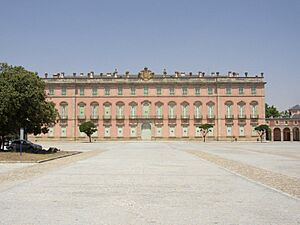Patrimonio Nacional facts for kids
| Patrimonio Nacional | |

The Spanish Royal Crown, symbol of Patrimonio Nacional
|
|
| Agency overview | |
|---|---|
| Formed | May 12, 1865 (as Crown Heritage) March 7, 1940 (as National Heritage) |
| Preceding agencies |
|
| Type | Autonomous agency |
| Jurisdiction | Spanish government |
| Headquarters | Royal Palace of Madrid |
| Employees | 1.231 (2020) |
| Annual budget | €149 million, 2023 |
| Agency executives |
|
| Parent department | Ministry of the Presidency |
| Website | Web Site |
Patrimonio Nacional (which means National Heritage in English) is a special organization in Spain. It's like a manager for many important places owned by the Spanish government. These places are used by the King and Queen of Spain and their family. They use them as homes and for important official events.
Patrimonio Nacional looks after amazing palaces, beautiful gardens, old monasteries, and convents. These are all called the Royal Sites. When the Royal Family isn't using them, many of these Royal Sites are open for everyone to visit! This organization also manages the official homes and holiday houses for the Prime Minister of Spain.
Contents
History of Patrimonio Nacional
This organization was first created in 1865. It was during the time of Queen Isabella II. Back then, it was called Patrimonio de la Corona, which means Heritage of the Crown.
Later, when her grandson Alfonso XIII was king, it was also known as Patrimonio Real (Royal Heritage). After that, during the Second Spanish Republic (1931–1939), it was named Patrimonio de la República (Heritage of the Republic). Finally, in 1940, a leader named Francisco Franco gave it the name Patrimonio Nacional, which it still has today.
What Patrimonio Nacional Does
Patrimonio Nacional does more than just manage buildings. It also organizes special events. They put on temporary art exhibitions and concerts in the Royal Sites.
They also publish many interesting things. This includes books about the Royal Collections and the Royal Sites. They even make copies of old books from the libraries of El Escorial and the Royal Library. You can also find visitor guides for the different sites and official photos of the King of Spain. They even have a magazine called Reales Sitios. It shares stories about the art and history of these amazing places.
It's important to know that the Royal Family has other palaces. But these specific palaces are not managed by Patrimonio Nacional.
Royal Sites to Explore
Royal Palaces
These are some of the grand palaces managed by Patrimonio Nacional:
- Royal Palace of Madrid (Madrid)
- Casita del Príncipe or Casita de Abajo (El Escorial)
- Casita del Príncipe (El Pardo)
- Casita del Infante (San Lorenzo de El Escorial)
- Royal Palace of Zarzuela (Madrid)
- Royal Site of San Lorenzo de El Escorial (San Lorenzo de El Escorial)
- Royal Palace of Aranjuez with its beautiful gardens and buildings (Aranjuez)
- Casa del Labrador (Aranjuez)
- Royal Palace of El Pardo (Madrid)
- Royal Palace of La Granja de San Ildefonso and its royal buildings (Real Sitio de San Ildefonso)
- Royal Palace of Riofrío (Real Sitio de San Ildefonso)
- Royal Palace of La Almudaina (Palma)
- Residencia Real de La Mareta (Teguise)
Royal Convents and Monasteries
Patrimonio Nacional also cares for many historic convents and monasteries:
- Royal Convent of Las Descalzas Reales (Madrid)
- Monastery of Yuste (Cuacos de Yuste)
- Royal Monastery of the Incarnation (Madrid)
- Royal Monastery of Santa Isabel (Madrid)
- Royal Convent of Santa Clara (Tordesillas)
- Abbey of Santa Maria la Real de Huelgas (Burgos)
- Royal Convent of San Pascual (Aranjuez)
- Colegio de Doncellas Nobles (Toledo)
- Benedictine Abbey of Santa Cruz del Valle de los Caídos (San Lorenzo de El Escorial)
- Pantheon of Illustrious Men (Madrid)
Homes for the Prime Minister
Patrimonio Nacional also manages these important residences for the Prime Minister of Spain:
- Palace of Moncloa (Madrid)
- Palace of Las Marismillas (Almonte)
- Coto Nacional de los Quintos de Mora (Los Yébenes)
Royal Collections Gallery
In addition to the exhibitions they hold, Patrimonio Nacional opened a new museum in 2023. It's called the Royal Collections Gallery. This museum shows off the amazing treasures and art collected by the Spanish Monarchy over many centuries.
See also
 In Spanish: Patrimonio Nacional para niños
In Spanish: Patrimonio Nacional para niños






